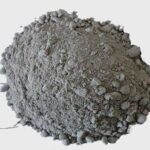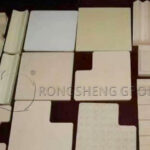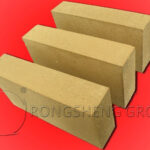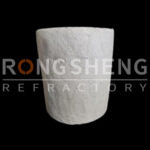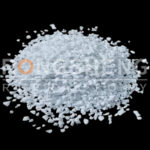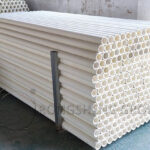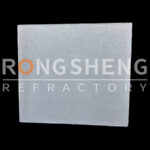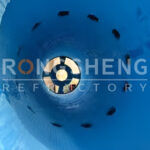Plastic Refractory Description
Plastic refractory is unshaped refractory with a certain degree of plasticity and can be applied by ramming method. Plastic refractory is usually produced and stored in mud shape won’t crack or spall during using. The deformation coefficient of plastic refractory is between 15%~40%. Plastic refractory is classified by binder types and main material types. By binding type, plastic refractory can be divided into clay bound plastic refractory, phosphate acid bound plastic refractory, aluminum phosphate plastic refractory and so on. By chemical property, plastic refractory can be classified into miro expansion plastic refractory, abrasion resistance plastic refractory, corrosion resistant plastic refractory and so on.
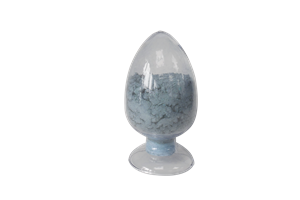
Phosphate Acid Bound Plastic Refractory
Phosphate acid bound plastic refractory adopts phosphate acid or acidic aluminum phosphate as binder, clay clinker, high alumina clinker or corundum as aggregate, plastic clay or conservant as additives, and is prepared as mud shape material. Phosphate acid bound plastic refractory has good middle and high temperature bonding strength, good abrasion resistance and thermal shock resistance.
When phosphate or acidic aluminum phosphate is used as binder, phosphate group will react with active Al2O3 in the raw material( plastic refractory, high alumina fines, corundum fines) and produce insolvable AlPO4.xH2O, which can result in the quick harden of the material and lose plasticity, so conservants is essential for phosphate acid bound plastic refractory. The preservation period can prolong from 6 months to about 1 year according to the quantity of conservants.
Phosphate Acid Bound Plastic Refractory Index
| Item | Clay | High alumina I | High alumina II |
| Al2O3 % | 45 | 60 | 72 |
| Bulk Density(110℃, 24h) g/cm3 | 2.25 | 2.55 | 2.60 |
| Sintering Linear change rate (1350℃, 3h) % | -0.5 | +0.35 | +0.53 |
| Cold rupture strength(110℃, 24h) Mpa | 4.0 | 5.3 | 5.5 |
| Compression strength(1000℃, 3h) | 30 | 45 | 43 |
| Plasticity Index % | 15~25 | 15~25 | 15~25 |
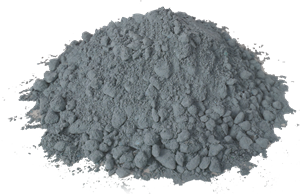
Phosphate Acid Bound Plastic Refractory Applications
Aluminum phosphate or phosphate acid bound plastic refractory are widely used in industrial kilns and furnaces of metallurgy, petrochemical, electric power and machinery industry. The main application is furnace lining, where thermal shock resistance, scouring resistance and abrasion resistance is required. For example, the burner nozzle of heating furnace, discharge hole of rotary cement kiln, charge hole of vertical kiln, high temperature cyclone separator and so on.
Aluminum Sulfate Bound Plastic Refractory
Aluminum sulfate bound plastic refractory adopts Aluminum sulfate solution as binder, clay clinker, high alumina clinker or corundum as aggregate, plastic clay or other materials as additives. It is a kind of mud shape plastic material. High temperature performance of aluminum sulfate plastic refractory is similar to phosphate acid bound plastic refractory, but the price is relatively lower. Aluminum sulfate plastic refractory is popularly used plastic refractory.
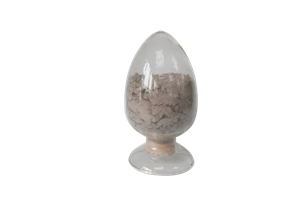
Aluminum Sulfate Bound Plastic Refractory Index
| Item | Clay | High alumina A | High alumina B |
| Al2O3 % | 43 | 60 | 73 |
| Bulk Density(dry) g/cm3 | 2.26 | 2.34 | 2.60 |
| Sintering Linear change rate (1400℃) % | +0.2 | +0.4 | +0.1 |
| Cold rupture strength(110℃, 24h) Mpa | 3.7 | 4.2 | 3.8 |
| Compression strength(1000℃, 3h) | 21.1 | 29.1 | 21.0 |
| Plasticity Index % | 15~30 | 15~30 | 15~30 |
Aluminum Sulfate Bound Plastic Refractory Application
The application sphere of aluminum sulfate bound plastic refractory is the same as clay bound plastic refractory, but aluminum sulfate plastic refractory has higher mechanical strength than clay bound plastic refractory, is suitable for industrial furnace inner lining where high structural strength is required. For example, can be used as annular heating furnace bottom precast block, forging furnace lining, vertical kiln inner lining, etc.
